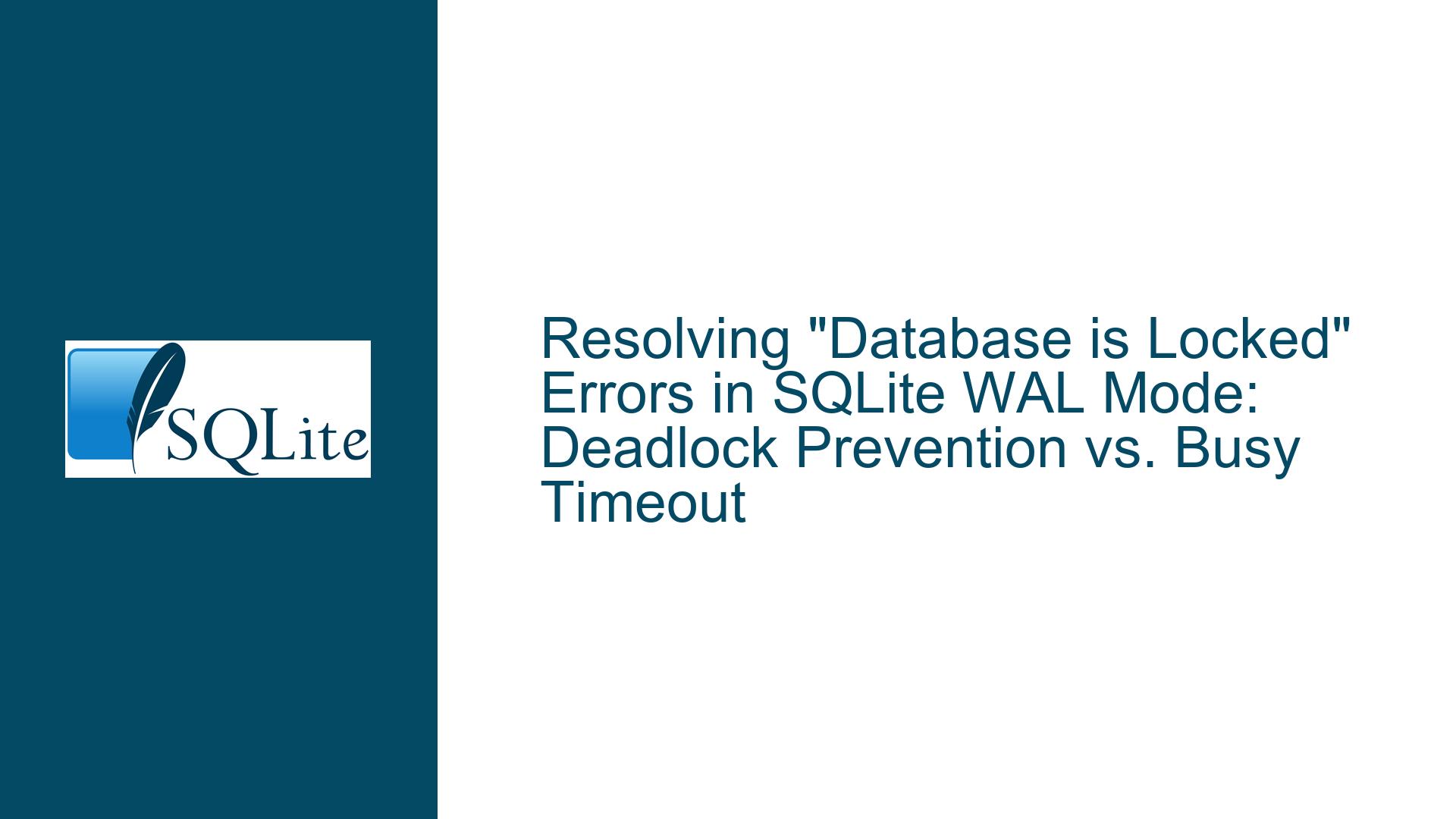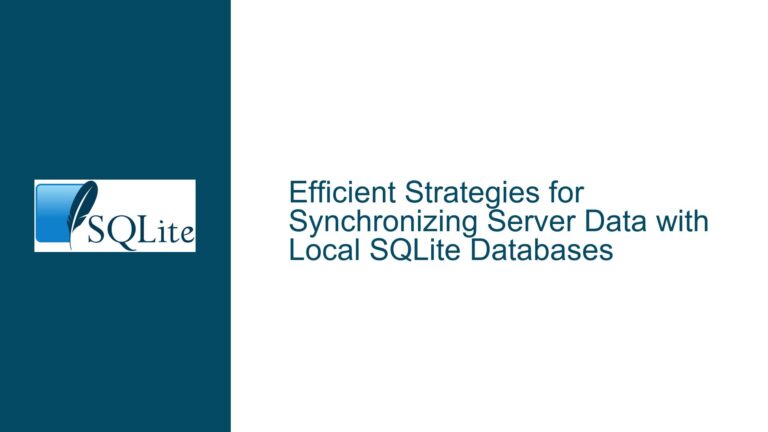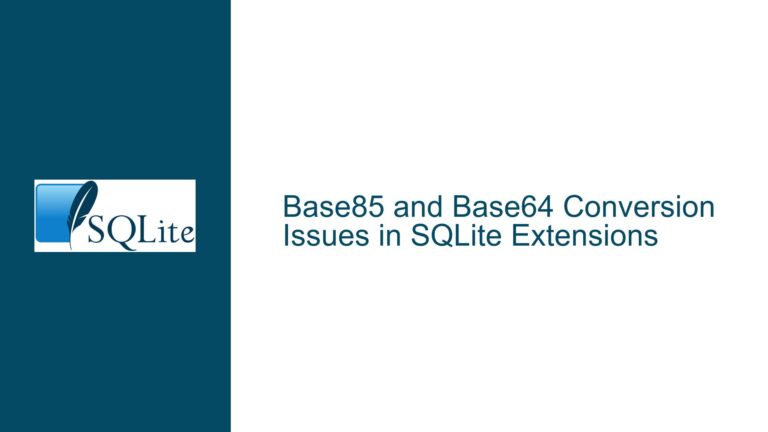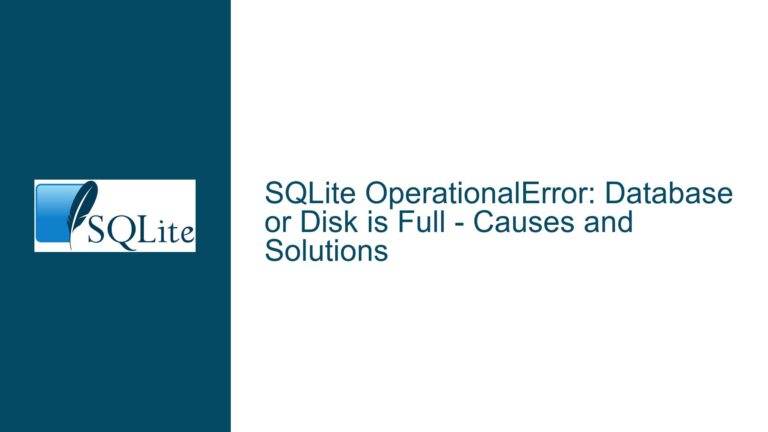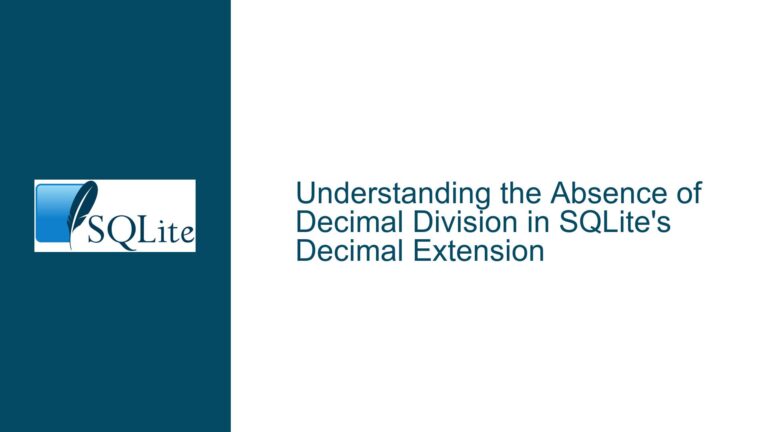Resolving “Database is Locked” Errors in SQLite WAL Mode: Deadlock Prevention vs. Busy Timeout
Understanding Concurrent Access Conflicts in SQLite WAL Mode With Intermittent SQLITE_BUSY Errors
Operational Context & Error Manifestation
The core issue involves an application experiencing intermittent "database is locked" errors (SQLITE_BUSY) during DELETE operations in a SQLite database configured with Write-Ahead Logging (WAL) mode. The environment consists of two concurrent connections to the same database:
- Writer Connection: Executes bulk DELETE operations within explicit transactions initiated via
BEGIN TRANSACTION - Reader Connection: Performs frequent SELECT queries (once per second) without explicit transaction control
Key operational parameters include:
- Busy timeout set to 100ms via
sqlite3_busy_timeout() - Database size ≈200KB with default cache_size (-2000 ≈ 2MB)
- WAL mode confirmed active through
.db-wal/.db-shmpresence andPRAGMA journal_modeverification
The error occurs exclusively on the writer thread during DELETE execution after successful transaction start. No prior history of this error exists across multiple deployments, suggesting rare contention scenarios rather than systematic design flaws.
Critical Behavior of WAL Mode
WAL mode allows concurrent reads and writes by design:
- Readers operate on database snapshots via shared-memory (SHM) coordination
- Writers append changes to WAL file without blocking readers
- Checkpointing (WAL->main database transfer) requires exclusive access
However, DELETE operations without WHERE clauses (full table scans) create unique challenges:
- May trigger internal cache spills to disk during large data traversal
- Require exclusive locks during final commit phases
- Risk page-level contention if reader connections hold long-lived snapshots
The combination of infrequent bulk writes and frequent reads creates conditions where lock acquisition timing becomes probabilistic rather than deterministic.
Root Cause Analysis: Why SQLITE_BUSY Occurs Despite Dedicated Writer
Transaction Initiation Mismatch (DEFERRED vs IMMEDIATE)
The writer uses BEGIN TRANSACTION (DEFERRED mode), which:
- Acquires SHARED lock initially
- Upgrades to RESERVED lock upon first write (DELETE)
- Requires EXCLUSIVE lock during commit
In WAL mode:
- RESERVED lock prevents other writers but allows concurrent readers
- EXCLUSIVE lock is only needed during checkpoint operations
Contention Scenario:
- Writer starts DEFERRED transaction (SHARED lock)
- Reader connection executes SELECT (acquires SHARED lock, starts snapshot)
- Writer attempts DELETE, upgrading to RESERVED lock (successful)
- During commit:
- Writer requires EXCLUSIVE lock for checkpoint
- Reader’s open snapshot blocks checkpoint completion
- Busy timeout expires before reader releases snapshot
This explains why the error manifests during DELETE execution rather than at transaction start. The 100ms timeout proves insufficient when readers maintain active snapshots during writer commit phases.
Cache Size Inadequacy During Large Operations
The default cache_size (-2000 = 2MB) may be suboptimal for:
- Tables with 20+ rows requiring full scan during DELETE
- WAL-index overflows during concurrent access
Insufficient cache forces premature spill to disk:
- Writer’s DELETE operation exhausts page cache
- Spill to disk requires temporary exclusive access
- Concurrent reader activity blocks spill completion
- Busy timeout triggers before spill can finalize
Phantom Locking From Unrecognized Connections
Though the user asserts only two connections exist, latent scenarios could create hidden locks:
- ORM layers creating temporary connections
- Unreleased prepared statements holding snapshots
- Background checkpoint threads (e.g., via
wal_autocheckpoint)
Misconfigured Journal Mode Fallback
While WAL mode was confirmed active post-error, transient failures during mode setting could cause rollback:
- Application executes
PRAGMA journal_mode=WALat startup - Fails to verify result (returns ‘wal’ vs ‘delete’/’memory’)
- Subsequent OS-level file locking reverts to rollback journal
- DELETE operation attempts proceed with stricter locking
Comprehensive Diagnostic & Remediation Protocol
Step 1: Implement Enhanced Lock Diagnostics
A. Capture Extended Error Codes
Modify error logging to include sqlite3_extended_errcode():
int err = sqlite3_exec(db, "DELETE FROM tablename", 0, 0, 0);
if (err != SQLITE_OK) {
log("Error %d (%s): %s",
sqlite3_extended_errcode(db),
sqlite3_errstr(sqlite3_extended_errcode(db)),
sqlite3_errmsg(db));
}
This distinguishes:
SQLITE_BUSY (5): Resource temporarily unavailableSQLITE_BUSY_SNAPSHOT (517): Write conflict in WAL modeSQLITE_LOCKED (6): Table-level lock contention
B. Install Custom Busy Handler
Implement callback-based busy handling to track retry attempts:
int busy_handler(void* data, int attempts) {
log("Busy handler invoked (attempt %d)", attempts);
usleep(100000); // 100ms delay between retries
return (attempts < 5); // Retry max 5 times
}
sqlite3_busy_handler(db, busy_handler, NULL);
This reveals whether errors result from:
- Immediate lock rejection (attempts=1)
- Timeout exhaustion (attempts>1)
C. Monitor Lock Status via Unlock Notify
For advanced diagnosis, use sqlite3_unlock_notify():
void unlock_callback(void** args, int num_args) {
log("Lock released by contending connection");
}
sqlite3_unlock_notify(db, unlock_callback, NULL);
This asynchronously detects when blocking connections release locks.
Step 2: Optimize Transaction & Lock Management
A. Use IMMEDIATE Transactions for Writes
Replace BEGIN TRANSACTION with BEGIN IMMEDIATE:
- Acquires RESERVED lock immediately
- Prevents reader connections from creating new snapshots
- Allows existing snapshots to complete
B. Enforce Maximum Snapshot Duration
Configure reader connection with:
PRAGMA wal_autocheckpoint = 1; // Aggressive WAL truncation
PRAGMA busy_timeout = 50; // Fail fast on contention
C. Isolate Writer Cache
Allocate dedicated page cache for writer connection:
sqlite3_db_config(db, SQLITE_DBCONFIG_ENABLE_LOAD_EXTENSION, 0, 0);
sqlite3_exec(db, "PRAGMA cache_size=-4000", 0, 0, 0); // 4MB cache
Step 3: Architectural Modifications for Contention Resistance
A. Partition Bulk Deletes
Replace atomic DELETEs with batched operations:
DELETE FROM tablename WHERE rowid IN
(SELECT rowid FROM tablename LIMIT 100);
B. Implement Retry Wrappers
Wrap write operations in exponential backoff logic:
def delete_with_retry(db, query, max_retries=3):
for attempt in range(max_retries):
try:
execute_query(db, query)
return True
except sqlite3.OperationalError as e:
if 'locked' not in str(e):
raise
sleep(2 ** attempt)
return False
C. Enable Write-Ahead Logging Verification
Add startup checks for persistent WAL mode:
sqlite3_stmt *stmt;
sqlite3_prepare_v2(db, "PRAGMA journal_mode", -1, &stmt, 0);
sqlite3_step(stmt);
const char* mode = (const char*)sqlite3_column_text(stmt, 0);
if (strcmp(mode, "wal") != 0) {
abort_with_error("WAL mode not active");
}
Step 4: Advanced Contention Analysis Tools
A. SQLITE_DEBUG Lock Monitoring
Compile SQLite with debugging symbols and analyze lock transitions:
./configure --enable-debug
gdb --args ./app_with_sqlite
(gdb) break sqlite3PagerLockingModeChange
B. Shared Memory Inspection
Directly examine WAL-index state via /dev/shm (Linux):
hexdump -C /dev/shm/db-shm-*
C. SQLite Trace Hooks
Log all lock-related API calls:
void trace_callback(unsigned mask, void* ctx, void* p, void* x) {
if (mask & SQLITE_TRACE_STMT) {
log("SQL: %s", sqlite3_expanded_sql((sqlite3_stmt*)p));
}
}
sqlite3_trace_v2(db, SQLITE_TRACE_STMT, trace_callback, NULL);
Final Recommendations
- Prefer IMMEDIATE Transactions: Eliminate lock upgrade races
- Size Cache to 2× Working Set: Prevent spill-induced contention
- Instrument All Lock Errors: Capture extended codes and retry counts
- Enforce Reader/Writer Isolation:
PRAGMA query_only=1on readers - Benchmark Timeout Thresholds: Use 10× average write duration
By systematically applying these diagnostics and optimizations, developers can resolve transient locking errors while maintaining WAL mode’s concurrency benefits. The key insight lies in recognizing that SQLITE_BUSY in WAL mode often reflects timing-sensitive resource contention rather than structural deadlocks, necessitating probabilistic mitigation strategies rather than deterministic lock ordering.
